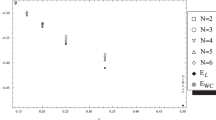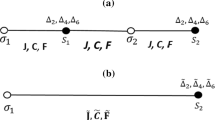Abstract
A generic Hamiltonian, which contains the potential energies and the coulomb interactions of an assembly of N 4He nuclei and 2N electrons is studied using second quantisation techniques and different sets of boundary conditions for three related problems. For an infinite volume of fluid periodic boundary conditions are imposed. For a finite volume which fills a cube the wave functions are chosen to vanish on the boundaries and for a finite volume contained in a vessel of arbitrary shape similar boundary conditions are imposed on a macroscopic volume of the liquid which is sufficiently remote from the walls and surface. In each example the appropriate value of N is determined by using the known density of the liquid. Use is also made of several other experimentally determined properties; that, at the lowest temperatures, the liquid is almost entirely super-fluid and that as the temperature is raised it appears to be composed of two homogeneously mixed fluids, the super- and the normal fluid, with little change in overall density. The first of these properties is used as a guide to a possible form for the ground state of an unperturbed Hamiltonian, that it should be a many-particle function that ensures that the density of particles and charge is uniform in space. The second is used to reason that each low-lying excited state of the unperturbed Hamiltonian will contain a part in which the ground state appears to have been expanded and the overall density has been restored by replacing the particles which have been removed in the expansion back into states which have not been used in forming the expanded ground state. A detailed examination of such a possibility shows that there are many possible ways of constructing mutually orthogonal states with this property. So the way is open to using these states as basis states for a perturbation theory and characterising them with a momentum variable, k. Another property, that the super-fluid supports longitudinal phonon-like modes is then used to define some more low-lying states, so enlarging the number of mutually orthogonal many-particle states. It is then a relatively simple exercise in perturbation theory to show how, after the meaning of the momentum variable, k, has been slightly changed, the famous (ε, k) dispersion curve emerges.
Similar content being viewed by others
References
R.D. Donnelly: Phys. World 10 (1997), No. 2.
G. Wannier: Phys. Rev. 52 (1937) 191.
J. Wilks: Liquid and Solid Helium. Clarendon Press, Oxford, 1967.
K.W.H. Stevens: Magnetic Ions in Crystals. Princeton University Press, Princeton (New Jersey), 1997.
H.R. Glyde, M.R. Gibbs, W.G. Stirling, and M.A. Adams: Europhys. Lett. 43 (1998) 422.
H.R. Glyde: Excitations in Liquid and Solid Helium. Clarendon Press, Oxford, 1994.
L.D. Landau: J. Phys. (Moscow) 5 (1941) 71.
Author information
Authors and Affiliations
Rights and permissions
About this article
Cite this article
Stevens, K.W.H. Towards a microscopic theory of superfluid 4He. Czechoslovak Journal of Physics 50, 1059–1074 (2000). https://doi.org/10.1023/A:1022835519935
Issue Date:
DOI: https://doi.org/10.1023/A:1022835519935




